Report on Samsung Brand Management: Strategies and Evaluation
VerifiedAdded on 2020/10/22
|21
|6342
|368
Report
AI Summary
This report provides a detailed analysis of Samsung's brand management strategies. It begins with an introduction to brand management and its importance, particularly in the context of Samsung, a global electronics company. The report explores the concept of brand equity, defining its components and outlining the steps involved in building a successful brand, including market research, value proposition, brand name selection, emotional connections, and consistent communication. The CBBE model (Customer-Based Brand Equity) is explained with examples. The report further examines Samsung's specific branding strategies, including promotional, design, and pricing strategies. The report also delves into brand portfolio management, different strategies and models, and techniques for measuring and managing brand value. It concludes by summarizing the key findings and the importance of branding for business success. The report also discusses the Aaker model of Brand equity and the benefits of branding, such as increasing business value and supporting advertising.

Brand Management
Paraphrase This Document
Need a fresh take? Get an instant paraphrase of this document with our AI Paraphraser
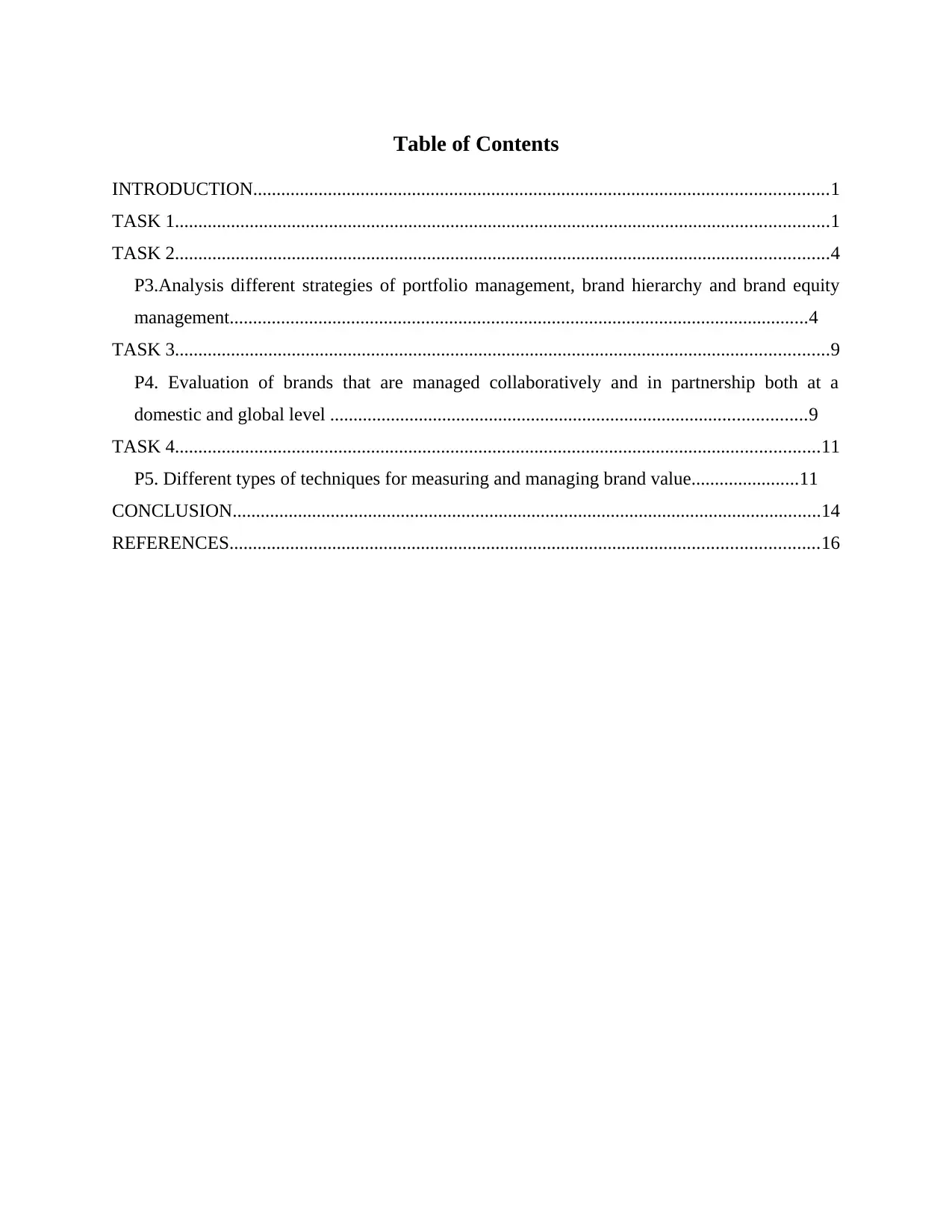
Table of Contents
INTRODUCTION...........................................................................................................................1
TASK 1............................................................................................................................................1
TASK 2............................................................................................................................................4
P3.Analysis different strategies of portfolio management, brand hierarchy and brand equity
management............................................................................................................................4
TASK 3............................................................................................................................................9
P4. Evaluation of brands that are managed collaboratively and in partnership both at a
domestic and global level ......................................................................................................9
TASK 4..........................................................................................................................................11
P5. Different types of techniques for measuring and managing brand value.......................11
CONCLUSION..............................................................................................................................14
REFERENCES..............................................................................................................................16
INTRODUCTION...........................................................................................................................1
TASK 1............................................................................................................................................1
TASK 2............................................................................................................................................4
P3.Analysis different strategies of portfolio management, brand hierarchy and brand equity
management............................................................................................................................4
TASK 3............................................................................................................................................9
P4. Evaluation of brands that are managed collaboratively and in partnership both at a
domestic and global level ......................................................................................................9
TASK 4..........................................................................................................................................11
P5. Different types of techniques for measuring and managing brand value.......................11
CONCLUSION..............................................................................................................................14
REFERENCES..............................................................................................................................16

⊘ This is a preview!⊘
Do you want full access?
Subscribe today to unlock all pages.

Trusted by 1+ million students worldwide
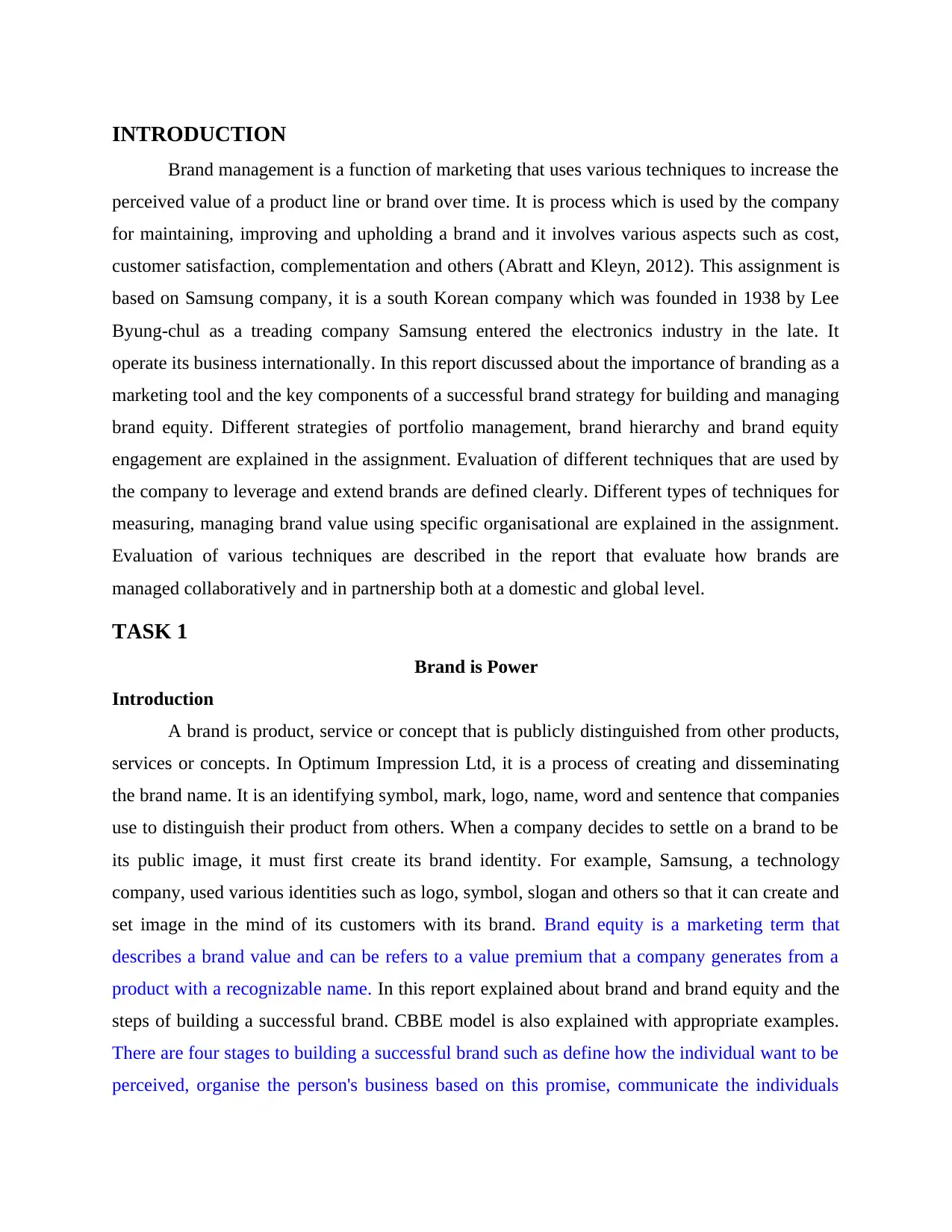
INTRODUCTION
Brand management is a function of marketing that uses various techniques to increase the
perceived value of a product line or brand over time. It is process which is used by the company
for maintaining, improving and upholding a brand and it involves various aspects such as cost,
customer satisfaction, complementation and others (Abratt and Kleyn, 2012). This assignment is
based on Samsung company, it is a south Korean company which was founded in 1938 by Lee
Byung-chul as a treading company Samsung entered the electronics industry in the late. It
operate its business internationally. In this report discussed about the importance of branding as a
marketing tool and the key components of a successful brand strategy for building and managing
brand equity. Different strategies of portfolio management, brand hierarchy and brand equity
engagement are explained in the assignment. Evaluation of different techniques that are used by
the company to leverage and extend brands are defined clearly. Different types of techniques for
measuring, managing brand value using specific organisational are explained in the assignment.
Evaluation of various techniques are described in the report that evaluate how brands are
managed collaboratively and in partnership both at a domestic and global level.
TASK 1
Brand is Power
Introduction
A brand is product, service or concept that is publicly distinguished from other products,
services or concepts. In Optimum Impression Ltd, it is a process of creating and disseminating
the brand name. It is an identifying symbol, mark, logo, name, word and sentence that companies
use to distinguish their product from others. When a company decides to settle on a brand to be
its public image, it must first create its brand identity. For example, Samsung, a technology
company, used various identities such as logo, symbol, slogan and others so that it can create and
set image in the mind of its customers with its brand. Brand equity is a marketing term that
describes a brand value and can be refers to a value premium that a company generates from a
product with a recognizable name. In this report explained about brand and brand equity and the
steps of building a successful brand. CBBE model is also explained with appropriate examples.
There are four stages to building a successful brand such as define how the individual want to be
perceived, organise the person's business based on this promise, communicate the individuals
Brand management is a function of marketing that uses various techniques to increase the
perceived value of a product line or brand over time. It is process which is used by the company
for maintaining, improving and upholding a brand and it involves various aspects such as cost,
customer satisfaction, complementation and others (Abratt and Kleyn, 2012). This assignment is
based on Samsung company, it is a south Korean company which was founded in 1938 by Lee
Byung-chul as a treading company Samsung entered the electronics industry in the late. It
operate its business internationally. In this report discussed about the importance of branding as a
marketing tool and the key components of a successful brand strategy for building and managing
brand equity. Different strategies of portfolio management, brand hierarchy and brand equity
engagement are explained in the assignment. Evaluation of different techniques that are used by
the company to leverage and extend brands are defined clearly. Different types of techniques for
measuring, managing brand value using specific organisational are explained in the assignment.
Evaluation of various techniques are described in the report that evaluate how brands are
managed collaboratively and in partnership both at a domestic and global level.
TASK 1
Brand is Power
Introduction
A brand is product, service or concept that is publicly distinguished from other products,
services or concepts. In Optimum Impression Ltd, it is a process of creating and disseminating
the brand name. It is an identifying symbol, mark, logo, name, word and sentence that companies
use to distinguish their product from others. When a company decides to settle on a brand to be
its public image, it must first create its brand identity. For example, Samsung, a technology
company, used various identities such as logo, symbol, slogan and others so that it can create and
set image in the mind of its customers with its brand. Brand equity is a marketing term that
describes a brand value and can be refers to a value premium that a company generates from a
product with a recognizable name. In this report explained about brand and brand equity and the
steps of building a successful brand. CBBE model is also explained with appropriate examples.
There are four stages to building a successful brand such as define how the individual want to be
perceived, organise the person's business based on this promise, communicate the individuals
Paraphrase This Document
Need a fresh take? Get an instant paraphrase of this document with our AI Paraphraser
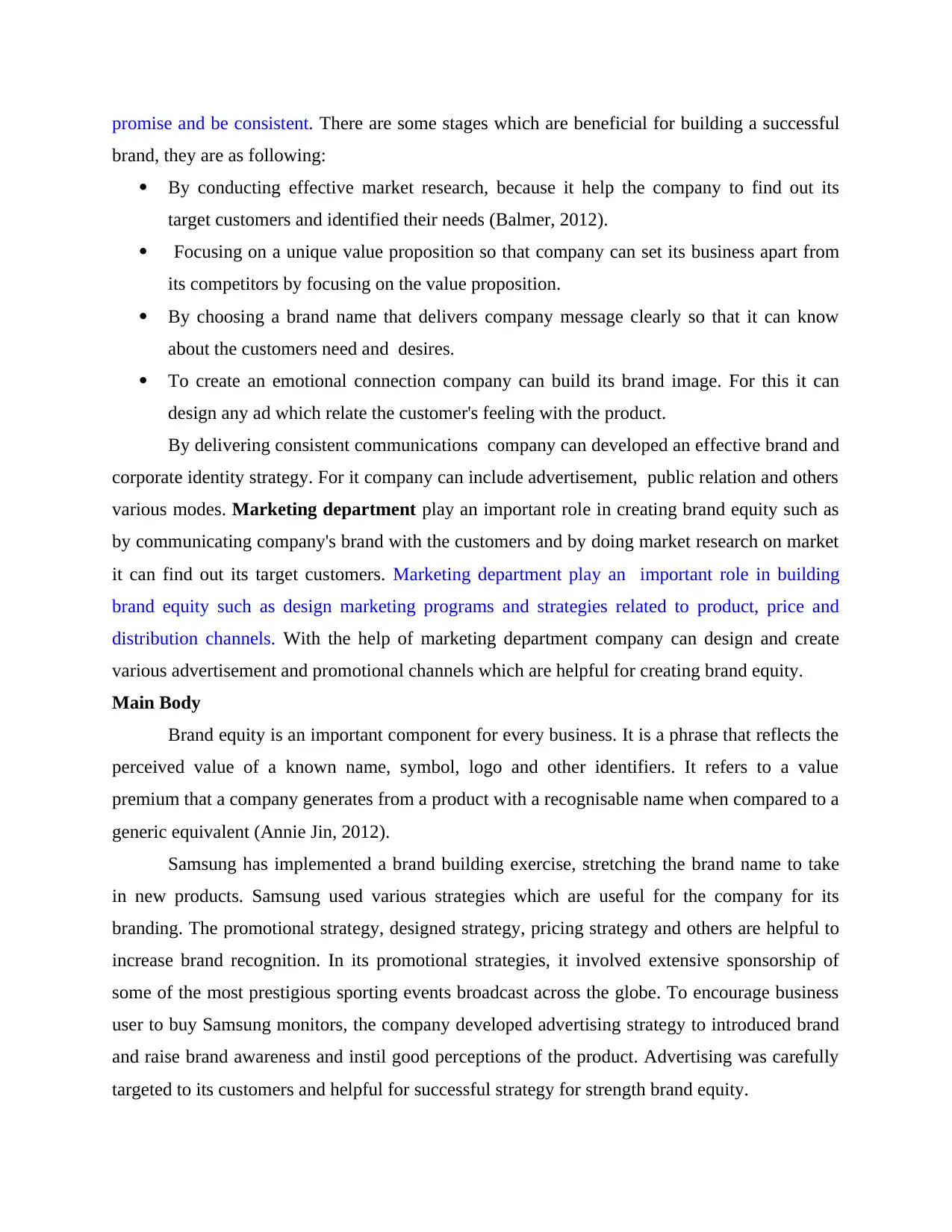
promise and be consistent. There are some stages which are beneficial for building a successful
brand, they are as following:
By conducting effective market research, because it help the company to find out its
target customers and identified their needs (Balmer, 2012).
Focusing on a unique value proposition so that company can set its business apart from
its competitors by focusing on the value proposition.
By choosing a brand name that delivers company message clearly so that it can know
about the customers need and desires.
To create an emotional connection company can build its brand image. For this it can
design any ad which relate the customer's feeling with the product.
By delivering consistent communications company can developed an effective brand and
corporate identity strategy. For it company can include advertisement, public relation and others
various modes. Marketing department play an important role in creating brand equity such as
by communicating company's brand with the customers and by doing market research on market
it can find out its target customers. Marketing department play an important role in building
brand equity such as design marketing programs and strategies related to product, price and
distribution channels. With the help of marketing department company can design and create
various advertisement and promotional channels which are helpful for creating brand equity.
Main Body
Brand equity is an important component for every business. It is a phrase that reflects the
perceived value of a known name, symbol, logo and other identifiers. It refers to a value
premium that a company generates from a product with a recognisable name when compared to a
generic equivalent (Annie Jin, 2012).
Samsung has implemented a brand building exercise, stretching the brand name to take
in new products. Samsung used various strategies which are useful for the company for its
branding. The promotional strategy, designed strategy, pricing strategy and others are helpful to
increase brand recognition. In its promotional strategies, it involved extensive sponsorship of
some of the most prestigious sporting events broadcast across the globe. To encourage business
user to buy Samsung monitors, the company developed advertising strategy to introduced brand
and raise brand awareness and instil good perceptions of the product. Advertising was carefully
targeted to its customers and helpful for successful strategy for strength brand equity.
brand, they are as following:
By conducting effective market research, because it help the company to find out its
target customers and identified their needs (Balmer, 2012).
Focusing on a unique value proposition so that company can set its business apart from
its competitors by focusing on the value proposition.
By choosing a brand name that delivers company message clearly so that it can know
about the customers need and desires.
To create an emotional connection company can build its brand image. For this it can
design any ad which relate the customer's feeling with the product.
By delivering consistent communications company can developed an effective brand and
corporate identity strategy. For it company can include advertisement, public relation and others
various modes. Marketing department play an important role in creating brand equity such as
by communicating company's brand with the customers and by doing market research on market
it can find out its target customers. Marketing department play an important role in building
brand equity such as design marketing programs and strategies related to product, price and
distribution channels. With the help of marketing department company can design and create
various advertisement and promotional channels which are helpful for creating brand equity.
Main Body
Brand equity is an important component for every business. It is a phrase that reflects the
perceived value of a known name, symbol, logo and other identifiers. It refers to a value
premium that a company generates from a product with a recognisable name when compared to a
generic equivalent (Annie Jin, 2012).
Samsung has implemented a brand building exercise, stretching the brand name to take
in new products. Samsung used various strategies which are useful for the company for its
branding. The promotional strategy, designed strategy, pricing strategy and others are helpful to
increase brand recognition. In its promotional strategies, it involved extensive sponsorship of
some of the most prestigious sporting events broadcast across the globe. To encourage business
user to buy Samsung monitors, the company developed advertising strategy to introduced brand
and raise brand awareness and instil good perceptions of the product. Advertising was carefully
targeted to its customers and helpful for successful strategy for strength brand equity.
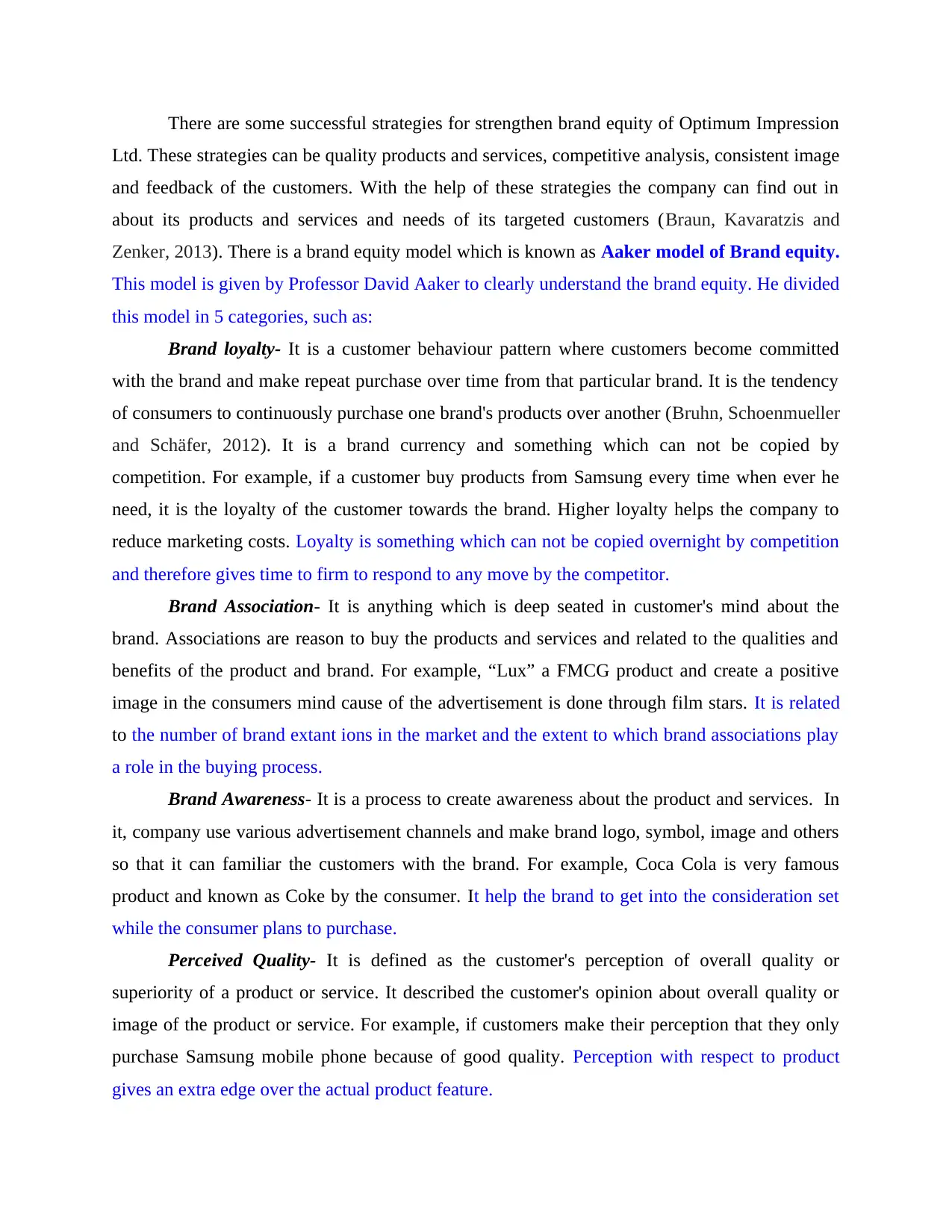
There are some successful strategies for strengthen brand equity of Optimum Impression
Ltd. These strategies can be quality products and services, competitive analysis, consistent image
and feedback of the customers. With the help of these strategies the company can find out in
about its products and services and needs of its targeted customers (Braun, Kavaratzis and
Zenker, 2013). There is a brand equity model which is known as Aaker model of Brand equity.
This model is given by Professor David Aaker to clearly understand the brand equity. He divided
this model in 5 categories, such as:
Brand loyalty- It is a customer behaviour pattern where customers become committed
with the brand and make repeat purchase over time from that particular brand. It is the tendency
of consumers to continuously purchase one brand's products over another (Bruhn, Schoenmueller
and Schäfer, 2012). It is a brand currency and something which can not be copied by
competition. For example, if a customer buy products from Samsung every time when ever he
need, it is the loyalty of the customer towards the brand. Higher loyalty helps the company to
reduce marketing costs. Loyalty is something which can not be copied overnight by competition
and therefore gives time to firm to respond to any move by the competitor.
Brand Association- It is anything which is deep seated in customer's mind about the
brand. Associations are reason to buy the products and services and related to the qualities and
benefits of the product and brand. For example, “Lux” a FMCG product and create a positive
image in the consumers mind cause of the advertisement is done through film stars. It is related
to the number of brand extant ions in the market and the extent to which brand associations play
a role in the buying process.
Brand Awareness- It is a process to create awareness about the product and services. In
it, company use various advertisement channels and make brand logo, symbol, image and others
so that it can familiar the customers with the brand. For example, Coca Cola is very famous
product and known as Coke by the consumer. It help the brand to get into the consideration set
while the consumer plans to purchase.
Perceived Quality- It is defined as the customer's perception of overall quality or
superiority of a product or service. It described the customer's opinion about overall quality or
image of the product or service. For example, if customers make their perception that they only
purchase Samsung mobile phone because of good quality. Perception with respect to product
gives an extra edge over the actual product feature.
Ltd. These strategies can be quality products and services, competitive analysis, consistent image
and feedback of the customers. With the help of these strategies the company can find out in
about its products and services and needs of its targeted customers (Braun, Kavaratzis and
Zenker, 2013). There is a brand equity model which is known as Aaker model of Brand equity.
This model is given by Professor David Aaker to clearly understand the brand equity. He divided
this model in 5 categories, such as:
Brand loyalty- It is a customer behaviour pattern where customers become committed
with the brand and make repeat purchase over time from that particular brand. It is the tendency
of consumers to continuously purchase one brand's products over another (Bruhn, Schoenmueller
and Schäfer, 2012). It is a brand currency and something which can not be copied by
competition. For example, if a customer buy products from Samsung every time when ever he
need, it is the loyalty of the customer towards the brand. Higher loyalty helps the company to
reduce marketing costs. Loyalty is something which can not be copied overnight by competition
and therefore gives time to firm to respond to any move by the competitor.
Brand Association- It is anything which is deep seated in customer's mind about the
brand. Associations are reason to buy the products and services and related to the qualities and
benefits of the product and brand. For example, “Lux” a FMCG product and create a positive
image in the consumers mind cause of the advertisement is done through film stars. It is related
to the number of brand extant ions in the market and the extent to which brand associations play
a role in the buying process.
Brand Awareness- It is a process to create awareness about the product and services. In
it, company use various advertisement channels and make brand logo, symbol, image and others
so that it can familiar the customers with the brand. For example, Coca Cola is very famous
product and known as Coke by the consumer. It help the brand to get into the consideration set
while the consumer plans to purchase.
Perceived Quality- It is defined as the customer's perception of overall quality or
superiority of a product or service. It described the customer's opinion about overall quality or
image of the product or service. For example, if customers make their perception that they only
purchase Samsung mobile phone because of good quality. Perception with respect to product
gives an extra edge over the actual product feature.
⊘ This is a preview!⊘
Do you want full access?
Subscribe today to unlock all pages.

Trusted by 1+ million students worldwide
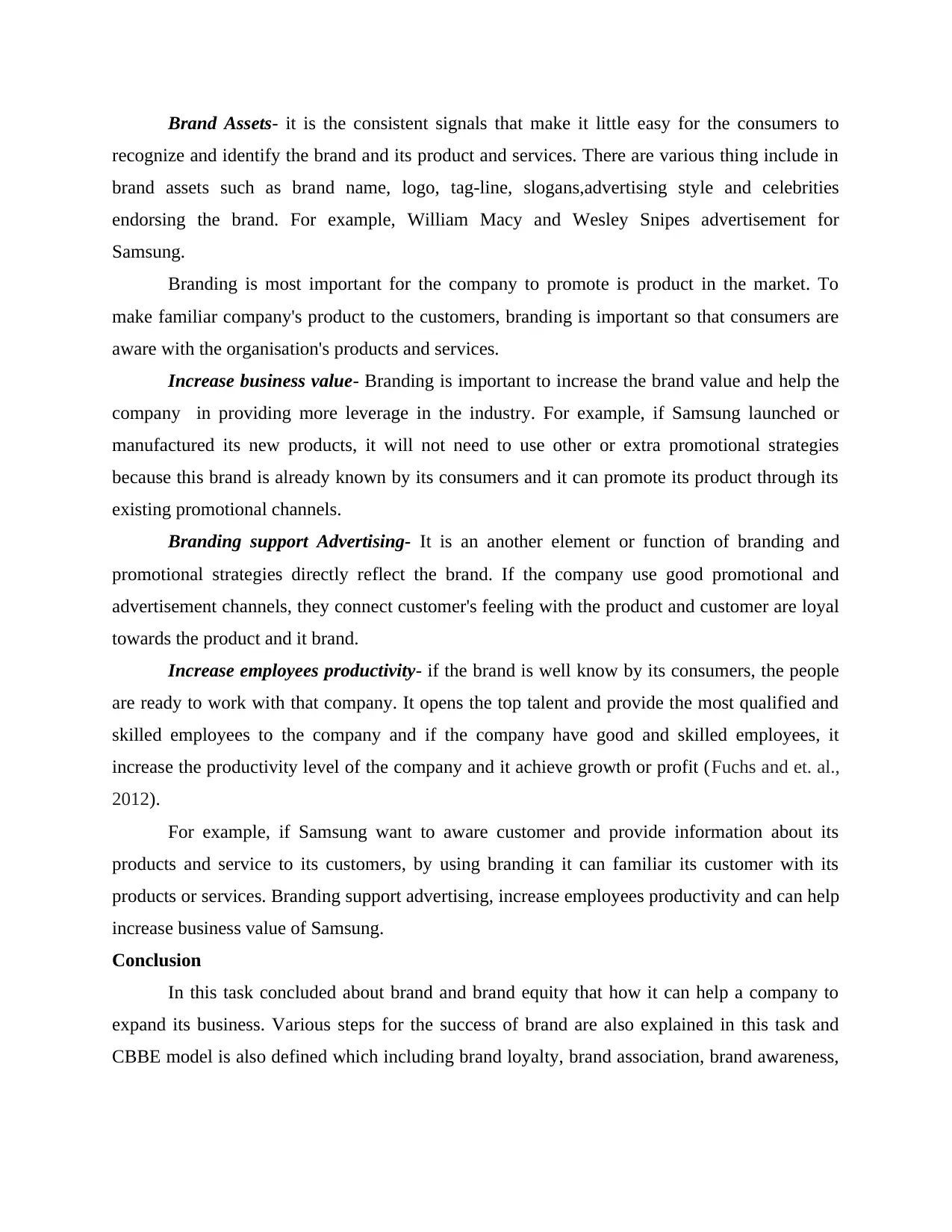
Brand Assets- it is the consistent signals that make it little easy for the consumers to
recognize and identify the brand and its product and services. There are various thing include in
brand assets such as brand name, logo, tag-line, slogans,advertising style and celebrities
endorsing the brand. For example, William Macy and Wesley Snipes advertisement for
Samsung.
Branding is most important for the company to promote is product in the market. To
make familiar company's product to the customers, branding is important so that consumers are
aware with the organisation's products and services.
Increase business value- Branding is important to increase the brand value and help the
company in providing more leverage in the industry. For example, if Samsung launched or
manufactured its new products, it will not need to use other or extra promotional strategies
because this brand is already known by its consumers and it can promote its product through its
existing promotional channels.
Branding support Advertising- It is an another element or function of branding and
promotional strategies directly reflect the brand. If the company use good promotional and
advertisement channels, they connect customer's feeling with the product and customer are loyal
towards the product and it brand.
Increase employees productivity- if the brand is well know by its consumers, the people
are ready to work with that company. It opens the top talent and provide the most qualified and
skilled employees to the company and if the company have good and skilled employees, it
increase the productivity level of the company and it achieve growth or profit (Fuchs and et. al.,
2012).
For example, if Samsung want to aware customer and provide information about its
products and service to its customers, by using branding it can familiar its customer with its
products or services. Branding support advertising, increase employees productivity and can help
increase business value of Samsung.
Conclusion
In this task concluded about brand and brand equity that how it can help a company to
expand its business. Various steps for the success of brand are also explained in this task and
CBBE model is also defined which including brand loyalty, brand association, brand awareness,
recognize and identify the brand and its product and services. There are various thing include in
brand assets such as brand name, logo, tag-line, slogans,advertising style and celebrities
endorsing the brand. For example, William Macy and Wesley Snipes advertisement for
Samsung.
Branding is most important for the company to promote is product in the market. To
make familiar company's product to the customers, branding is important so that consumers are
aware with the organisation's products and services.
Increase business value- Branding is important to increase the brand value and help the
company in providing more leverage in the industry. For example, if Samsung launched or
manufactured its new products, it will not need to use other or extra promotional strategies
because this brand is already known by its consumers and it can promote its product through its
existing promotional channels.
Branding support Advertising- It is an another element or function of branding and
promotional strategies directly reflect the brand. If the company use good promotional and
advertisement channels, they connect customer's feeling with the product and customer are loyal
towards the product and it brand.
Increase employees productivity- if the brand is well know by its consumers, the people
are ready to work with that company. It opens the top talent and provide the most qualified and
skilled employees to the company and if the company have good and skilled employees, it
increase the productivity level of the company and it achieve growth or profit (Fuchs and et. al.,
2012).
For example, if Samsung want to aware customer and provide information about its
products and service to its customers, by using branding it can familiar its customer with its
products or services. Branding support advertising, increase employees productivity and can help
increase business value of Samsung.
Conclusion
In this task concluded about brand and brand equity that how it can help a company to
expand its business. Various steps for the success of brand are also explained in this task and
CBBE model is also defined which including brand loyalty, brand association, brand awareness,
Paraphrase This Document
Need a fresh take? Get an instant paraphrase of this document with our AI Paraphraser
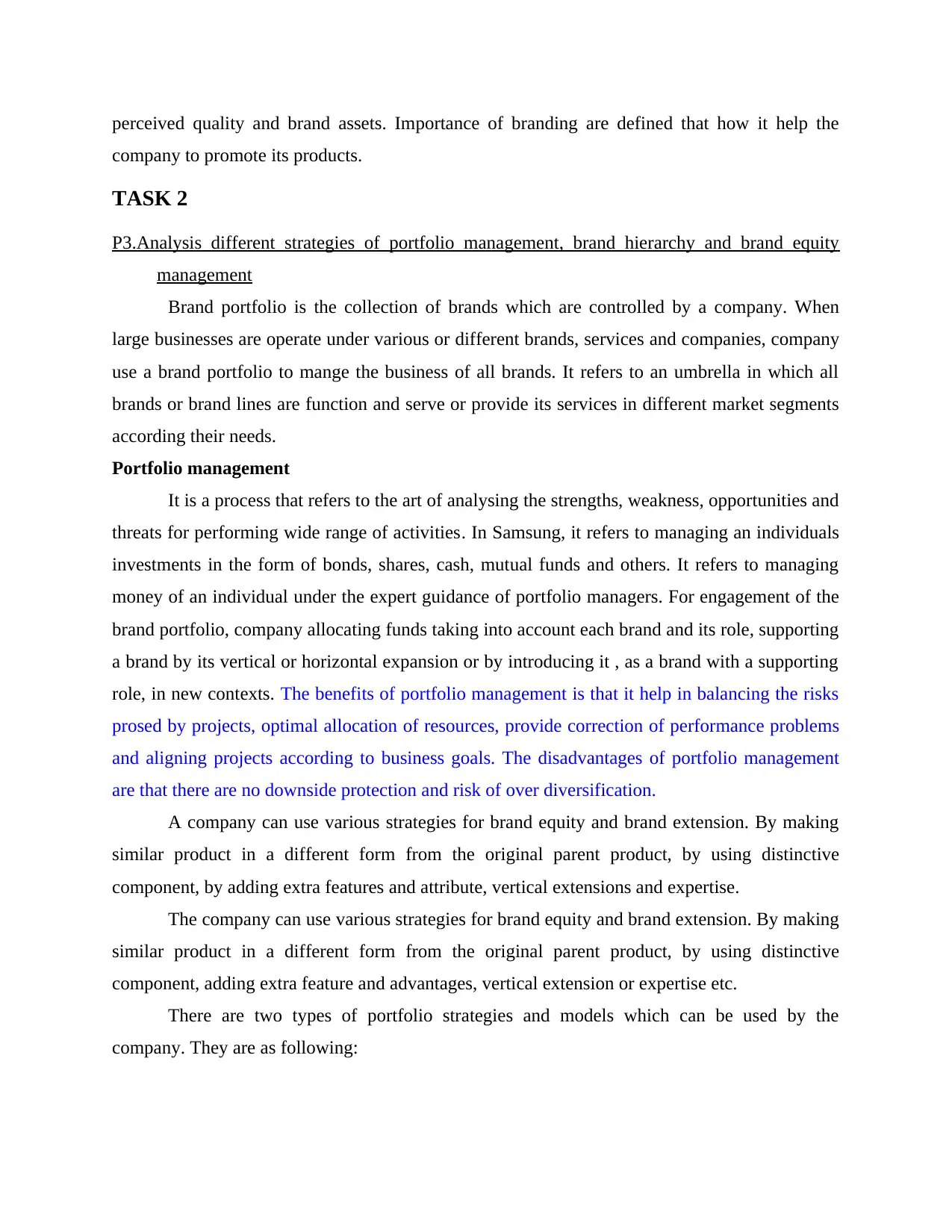
perceived quality and brand assets. Importance of branding are defined that how it help the
company to promote its products.
TASK 2
P3.Analysis different strategies of portfolio management, brand hierarchy and brand equity
management
Brand portfolio is the collection of brands which are controlled by a company. When
large businesses are operate under various or different brands, services and companies, company
use a brand portfolio to mange the business of all brands. It refers to an umbrella in which all
brands or brand lines are function and serve or provide its services in different market segments
according their needs.
Portfolio management
It is a process that refers to the art of analysing the strengths, weakness, opportunities and
threats for performing wide range of activities. In Samsung, it refers to managing an individuals
investments in the form of bonds, shares, cash, mutual funds and others. It refers to managing
money of an individual under the expert guidance of portfolio managers. For engagement of the
brand portfolio, company allocating funds taking into account each brand and its role, supporting
a brand by its vertical or horizontal expansion or by introducing it , as a brand with a supporting
role, in new contexts. The benefits of portfolio management is that it help in balancing the risks
prosed by projects, optimal allocation of resources, provide correction of performance problems
and aligning projects according to business goals. The disadvantages of portfolio management
are that there are no downside protection and risk of over diversification.
A company can use various strategies for brand equity and brand extension. By making
similar product in a different form from the original parent product, by using distinctive
component, by adding extra features and attribute, vertical extensions and expertise.
The company can use various strategies for brand equity and brand extension. By making
similar product in a different form from the original parent product, by using distinctive
component, adding extra feature and advantages, vertical extension or expertise etc.
There are two types of portfolio strategies and models which can be used by the
company. They are as following:
company to promote its products.
TASK 2
P3.Analysis different strategies of portfolio management, brand hierarchy and brand equity
management
Brand portfolio is the collection of brands which are controlled by a company. When
large businesses are operate under various or different brands, services and companies, company
use a brand portfolio to mange the business of all brands. It refers to an umbrella in which all
brands or brand lines are function and serve or provide its services in different market segments
according their needs.
Portfolio management
It is a process that refers to the art of analysing the strengths, weakness, opportunities and
threats for performing wide range of activities. In Samsung, it refers to managing an individuals
investments in the form of bonds, shares, cash, mutual funds and others. It refers to managing
money of an individual under the expert guidance of portfolio managers. For engagement of the
brand portfolio, company allocating funds taking into account each brand and its role, supporting
a brand by its vertical or horizontal expansion or by introducing it , as a brand with a supporting
role, in new contexts. The benefits of portfolio management is that it help in balancing the risks
prosed by projects, optimal allocation of resources, provide correction of performance problems
and aligning projects according to business goals. The disadvantages of portfolio management
are that there are no downside protection and risk of over diversification.
A company can use various strategies for brand equity and brand extension. By making
similar product in a different form from the original parent product, by using distinctive
component, by adding extra features and attribute, vertical extensions and expertise.
The company can use various strategies for brand equity and brand extension. By making
similar product in a different form from the original parent product, by using distinctive
component, adding extra feature and advantages, vertical extension or expertise etc.
There are two types of portfolio strategies and models which can be used by the
company. They are as following:
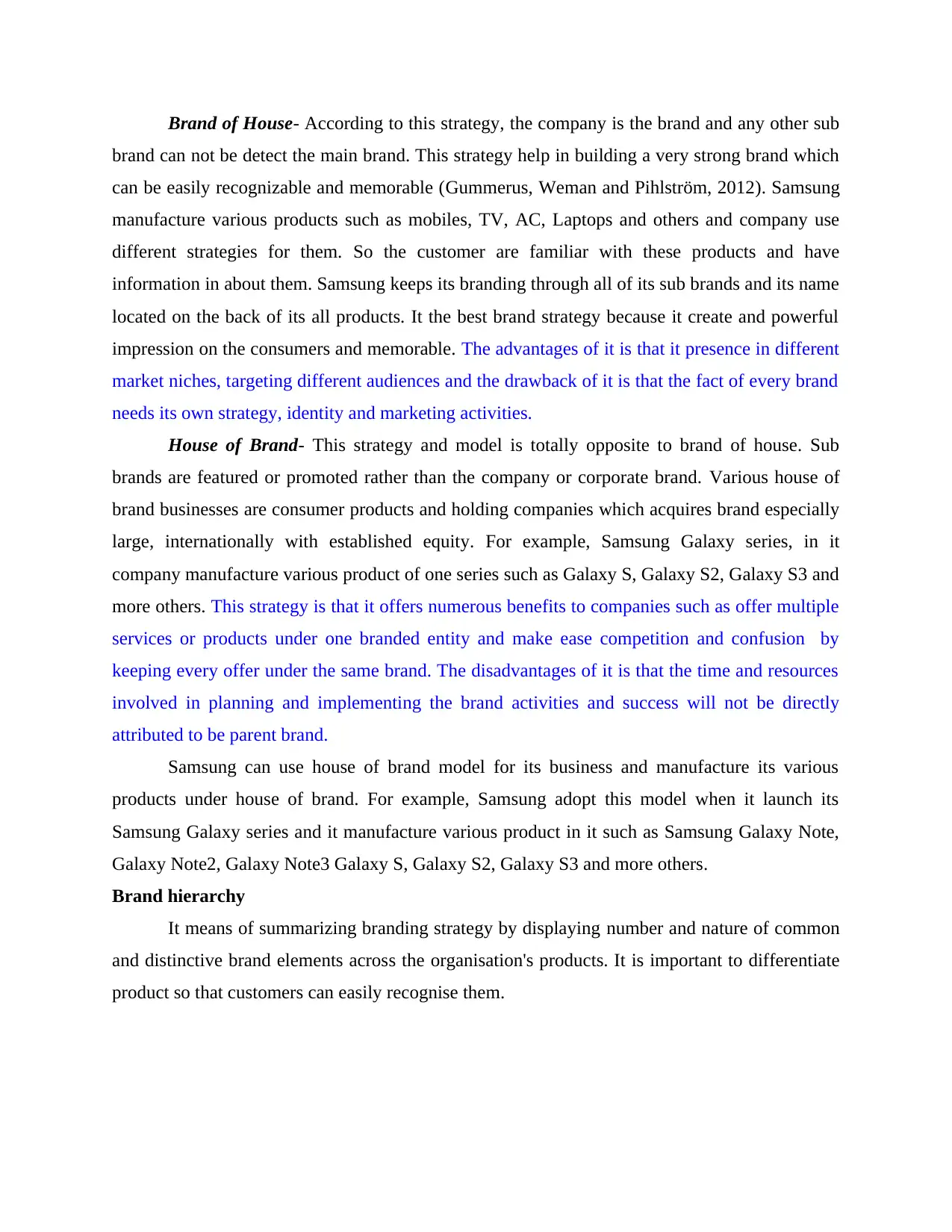
Brand of House- According to this strategy, the company is the brand and any other sub
brand can not be detect the main brand. This strategy help in building a very strong brand which
can be easily recognizable and memorable (Gummerus, Weman and Pihlström, 2012). Samsung
manufacture various products such as mobiles, TV, AC, Laptops and others and company use
different strategies for them. So the customer are familiar with these products and have
information in about them. Samsung keeps its branding through all of its sub brands and its name
located on the back of its all products. It the best brand strategy because it create and powerful
impression on the consumers and memorable. The advantages of it is that it presence in different
market niches, targeting different audiences and the drawback of it is that the fact of every brand
needs its own strategy, identity and marketing activities.
House of Brand- This strategy and model is totally opposite to brand of house. Sub
brands are featured or promoted rather than the company or corporate brand. Various house of
brand businesses are consumer products and holding companies which acquires brand especially
large, internationally with established equity. For example, Samsung Galaxy series, in it
company manufacture various product of one series such as Galaxy S, Galaxy S2, Galaxy S3 and
more others. This strategy is that it offers numerous benefits to companies such as offer multiple
services or products under one branded entity and make ease competition and confusion by
keeping every offer under the same brand. The disadvantages of it is that the time and resources
involved in planning and implementing the brand activities and success will not be directly
attributed to be parent brand.
Samsung can use house of brand model for its business and manufacture its various
products under house of brand. For example, Samsung adopt this model when it launch its
Samsung Galaxy series and it manufacture various product in it such as Samsung Galaxy Note,
Galaxy Note2, Galaxy Note3 Galaxy S, Galaxy S2, Galaxy S3 and more others.
Brand hierarchy
It means of summarizing branding strategy by displaying number and nature of common
and distinctive brand elements across the organisation's products. It is important to differentiate
product so that customers can easily recognise them.
brand can not be detect the main brand. This strategy help in building a very strong brand which
can be easily recognizable and memorable (Gummerus, Weman and Pihlström, 2012). Samsung
manufacture various products such as mobiles, TV, AC, Laptops and others and company use
different strategies for them. So the customer are familiar with these products and have
information in about them. Samsung keeps its branding through all of its sub brands and its name
located on the back of its all products. It the best brand strategy because it create and powerful
impression on the consumers and memorable. The advantages of it is that it presence in different
market niches, targeting different audiences and the drawback of it is that the fact of every brand
needs its own strategy, identity and marketing activities.
House of Brand- This strategy and model is totally opposite to brand of house. Sub
brands are featured or promoted rather than the company or corporate brand. Various house of
brand businesses are consumer products and holding companies which acquires brand especially
large, internationally with established equity. For example, Samsung Galaxy series, in it
company manufacture various product of one series such as Galaxy S, Galaxy S2, Galaxy S3 and
more others. This strategy is that it offers numerous benefits to companies such as offer multiple
services or products under one branded entity and make ease competition and confusion by
keeping every offer under the same brand. The disadvantages of it is that the time and resources
involved in planning and implementing the brand activities and success will not be directly
attributed to be parent brand.
Samsung can use house of brand model for its business and manufacture its various
products under house of brand. For example, Samsung adopt this model when it launch its
Samsung Galaxy series and it manufacture various product in it such as Samsung Galaxy Note,
Galaxy Note2, Galaxy Note3 Galaxy S, Galaxy S2, Galaxy S3 and more others.
Brand hierarchy
It means of summarizing branding strategy by displaying number and nature of common
and distinctive brand elements across the organisation's products. It is important to differentiate
product so that customers can easily recognise them.
⊘ This is a preview!⊘
Do you want full access?
Subscribe today to unlock all pages.

Trusted by 1+ million students worldwide
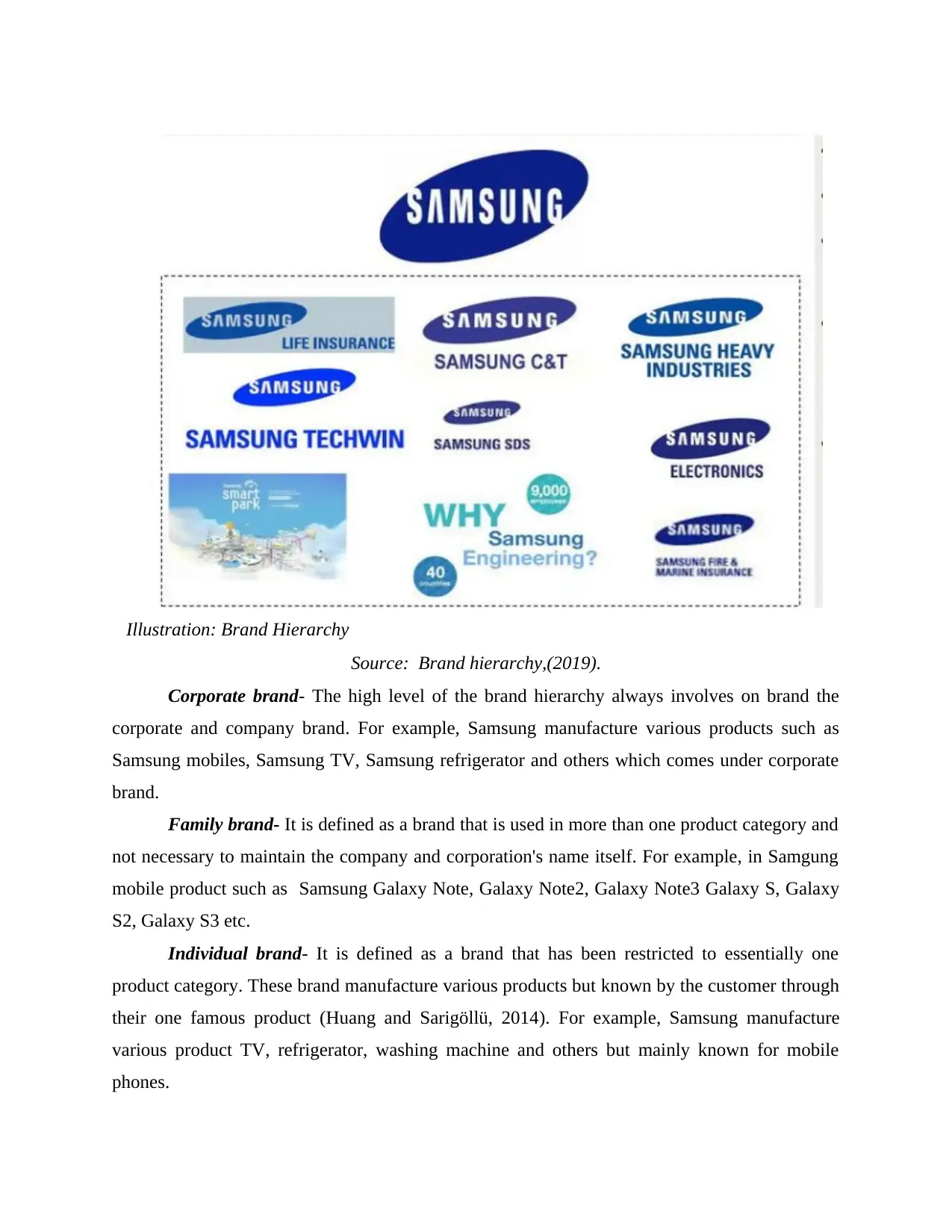
Source: Brand hierarchy,(2019).
Corporate brand- The high level of the brand hierarchy always involves on brand the
corporate and company brand. For example, Samsung manufacture various products such as
Samsung mobiles, Samsung TV, Samsung refrigerator and others which comes under corporate
brand.
Family brand- It is defined as a brand that is used in more than one product category and
not necessary to maintain the company and corporation's name itself. For example, in Samgung
mobile product such as Samsung Galaxy Note, Galaxy Note2, Galaxy Note3 Galaxy S, Galaxy
S2, Galaxy S3 etc.
Individual brand- It is defined as a brand that has been restricted to essentially one
product category. These brand manufacture various products but known by the customer through
their one famous product (Huang and Sarigöllü, 2014). For example, Samsung manufacture
various product TV, refrigerator, washing machine and others but mainly known for mobile
phones.
Illustration: Brand Hierarchy
Corporate brand- The high level of the brand hierarchy always involves on brand the
corporate and company brand. For example, Samsung manufacture various products such as
Samsung mobiles, Samsung TV, Samsung refrigerator and others which comes under corporate
brand.
Family brand- It is defined as a brand that is used in more than one product category and
not necessary to maintain the company and corporation's name itself. For example, in Samgung
mobile product such as Samsung Galaxy Note, Galaxy Note2, Galaxy Note3 Galaxy S, Galaxy
S2, Galaxy S3 etc.
Individual brand- It is defined as a brand that has been restricted to essentially one
product category. These brand manufacture various products but known by the customer through
their one famous product (Huang and Sarigöllü, 2014). For example, Samsung manufacture
various product TV, refrigerator, washing machine and others but mainly known for mobile
phones.
Illustration: Brand Hierarchy
Paraphrase This Document
Need a fresh take? Get an instant paraphrase of this document with our AI Paraphraser
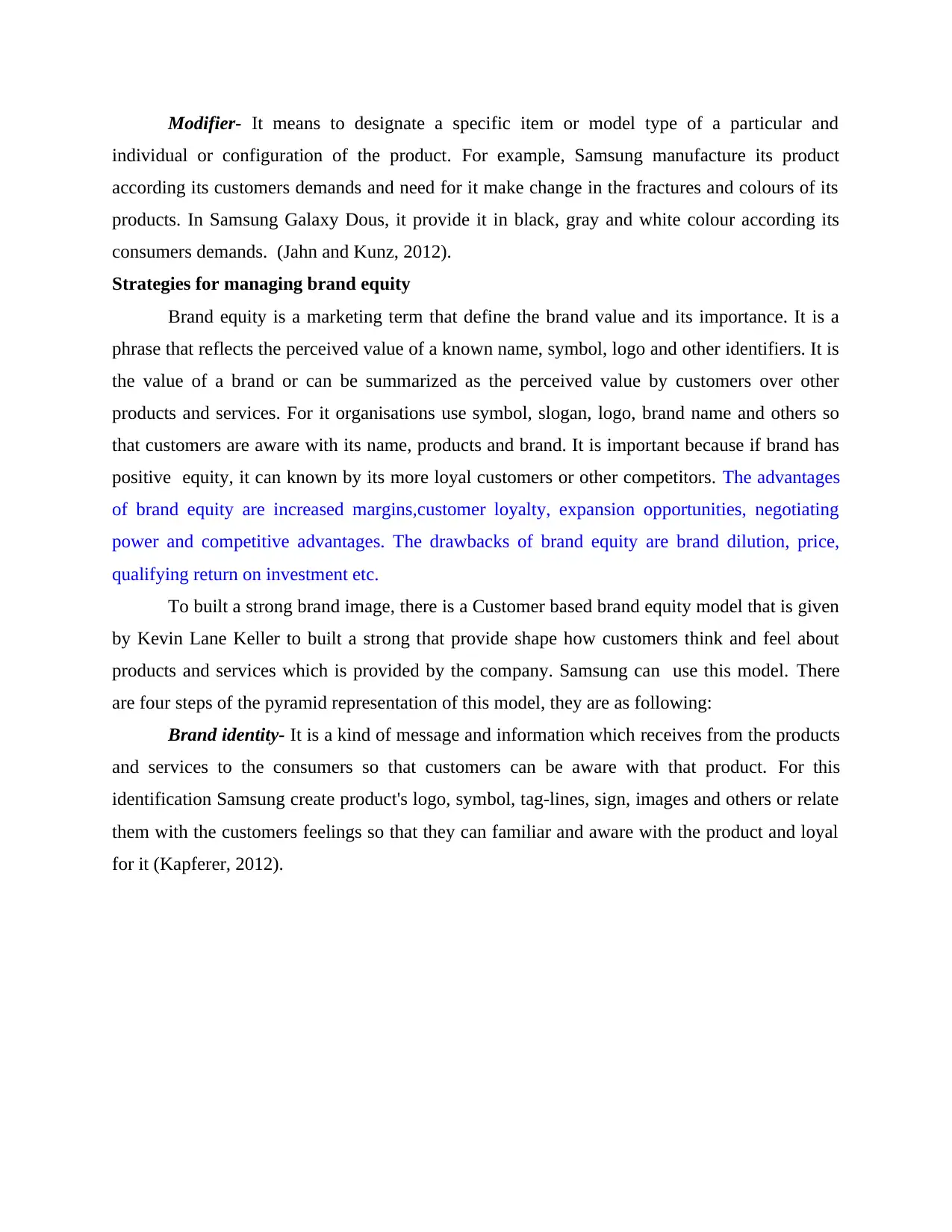
Modifier- It means to designate a specific item or model type of a particular and
individual or configuration of the product. For example, Samsung manufacture its product
according its customers demands and need for it make change in the fractures and colours of its
products. In Samsung Galaxy Dous, it provide it in black, gray and white colour according its
consumers demands. (Jahn and Kunz, 2012).
Strategies for managing brand equity
Brand equity is a marketing term that define the brand value and its importance. It is a
phrase that reflects the perceived value of a known name, symbol, logo and other identifiers. It is
the value of a brand or can be summarized as the perceived value by customers over other
products and services. For it organisations use symbol, slogan, logo, brand name and others so
that customers are aware with its name, products and brand. It is important because if brand has
positive equity, it can known by its more loyal customers or other competitors. The advantages
of brand equity are increased margins,customer loyalty, expansion opportunities, negotiating
power and competitive advantages. The drawbacks of brand equity are brand dilution, price,
qualifying return on investment etc.
To built a strong brand image, there is a Customer based brand equity model that is given
by Kevin Lane Keller to built a strong that provide shape how customers think and feel about
products and services which is provided by the company. Samsung can use this model. There
are four steps of the pyramid representation of this model, they are as following:
Brand identity- It is a kind of message and information which receives from the products
and services to the consumers so that customers can be aware with that product. For this
identification Samsung create product's logo, symbol, tag-lines, sign, images and others or relate
them with the customers feelings so that they can familiar and aware with the product and loyal
for it (Kapferer, 2012).
individual or configuration of the product. For example, Samsung manufacture its product
according its customers demands and need for it make change in the fractures and colours of its
products. In Samsung Galaxy Dous, it provide it in black, gray and white colour according its
consumers demands. (Jahn and Kunz, 2012).
Strategies for managing brand equity
Brand equity is a marketing term that define the brand value and its importance. It is a
phrase that reflects the perceived value of a known name, symbol, logo and other identifiers. It is
the value of a brand or can be summarized as the perceived value by customers over other
products and services. For it organisations use symbol, slogan, logo, brand name and others so
that customers are aware with its name, products and brand. It is important because if brand has
positive equity, it can known by its more loyal customers or other competitors. The advantages
of brand equity are increased margins,customer loyalty, expansion opportunities, negotiating
power and competitive advantages. The drawbacks of brand equity are brand dilution, price,
qualifying return on investment etc.
To built a strong brand image, there is a Customer based brand equity model that is given
by Kevin Lane Keller to built a strong that provide shape how customers think and feel about
products and services which is provided by the company. Samsung can use this model. There
are four steps of the pyramid representation of this model, they are as following:
Brand identity- It is a kind of message and information which receives from the products
and services to the consumers so that customers can be aware with that product. For this
identification Samsung create product's logo, symbol, tag-lines, sign, images and others or relate
them with the customers feelings so that they can familiar and aware with the product and loyal
for it (Kapferer, 2012).
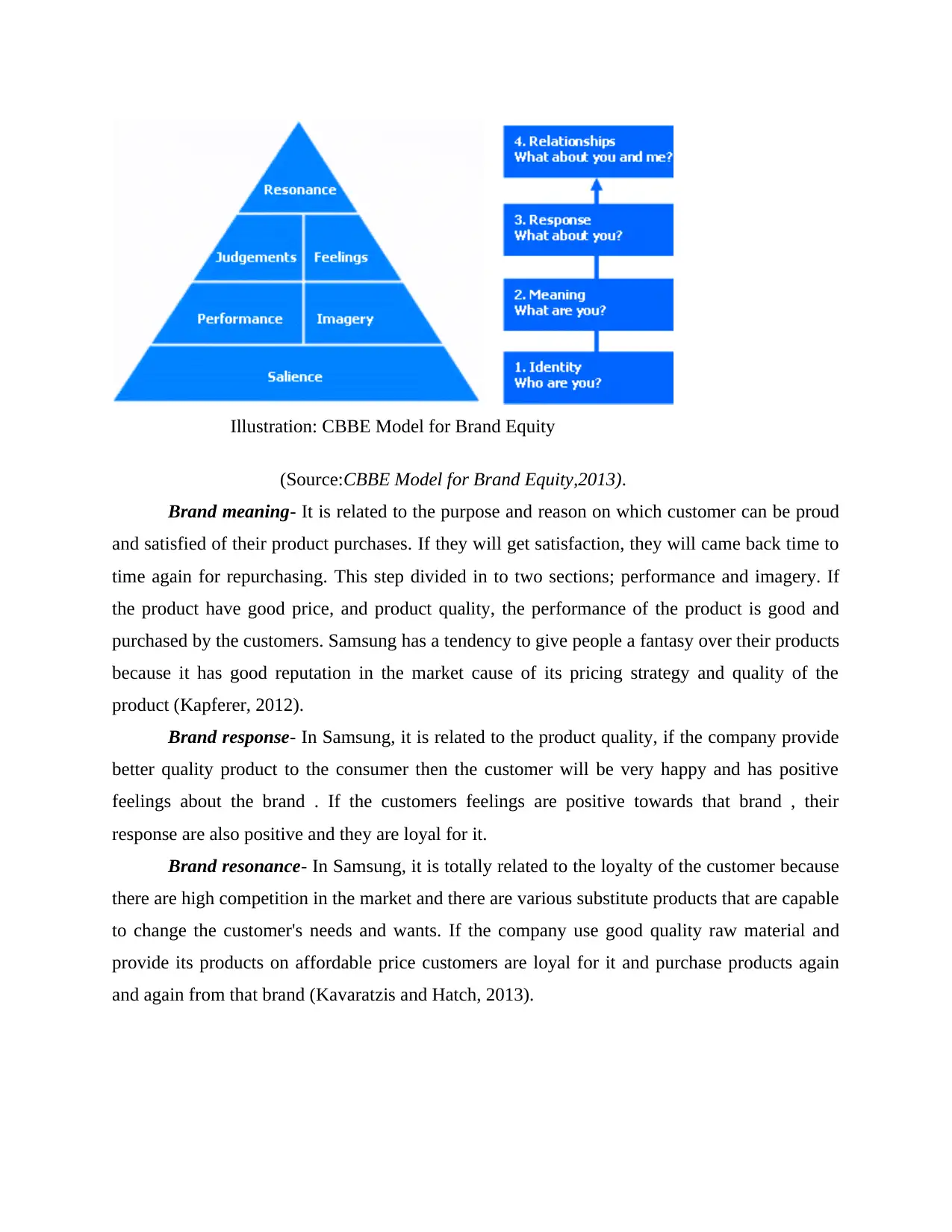
Illustration: CBBE Model for Brand Equity
(Source:CBBE Model for Brand Equity,2013).
Brand meaning- It is related to the purpose and reason on which customer can be proud
and satisfied of their product purchases. If they will get satisfaction, they will came back time to
time again for repurchasing. This step divided in to two sections; performance and imagery. If
the product have good price, and product quality, the performance of the product is good and
purchased by the customers. Samsung has a tendency to give people a fantasy over their products
because it has good reputation in the market cause of its pricing strategy and quality of the
product (Kapferer, 2012).
Brand response- In Samsung, it is related to the product quality, if the company provide
better quality product to the consumer then the customer will be very happy and has positive
feelings about the brand . If the customers feelings are positive towards that brand , their
response are also positive and they are loyal for it.
Brand resonance- In Samsung, it is totally related to the loyalty of the customer because
there are high competition in the market and there are various substitute products that are capable
to change the customer's needs and wants. If the company use good quality raw material and
provide its products on affordable price customers are loyal for it and purchase products again
and again from that brand (Kavaratzis and Hatch, 2013).
(Source:CBBE Model for Brand Equity,2013).
Brand meaning- It is related to the purpose and reason on which customer can be proud
and satisfied of their product purchases. If they will get satisfaction, they will came back time to
time again for repurchasing. This step divided in to two sections; performance and imagery. If
the product have good price, and product quality, the performance of the product is good and
purchased by the customers. Samsung has a tendency to give people a fantasy over their products
because it has good reputation in the market cause of its pricing strategy and quality of the
product (Kapferer, 2012).
Brand response- In Samsung, it is related to the product quality, if the company provide
better quality product to the consumer then the customer will be very happy and has positive
feelings about the brand . If the customers feelings are positive towards that brand , their
response are also positive and they are loyal for it.
Brand resonance- In Samsung, it is totally related to the loyalty of the customer because
there are high competition in the market and there are various substitute products that are capable
to change the customer's needs and wants. If the company use good quality raw material and
provide its products on affordable price customers are loyal for it and purchase products again
and again from that brand (Kavaratzis and Hatch, 2013).
⊘ This is a preview!⊘
Do you want full access?
Subscribe today to unlock all pages.

Trusted by 1+ million students worldwide
1 out of 21
Related Documents
Your All-in-One AI-Powered Toolkit for Academic Success.
+13062052269
info@desklib.com
Available 24*7 on WhatsApp / Email
![[object Object]](/_next/static/media/star-bottom.7253800d.svg)
Unlock your academic potential
Copyright © 2020–2025 A2Z Services. All Rights Reserved. Developed and managed by ZUCOL.




